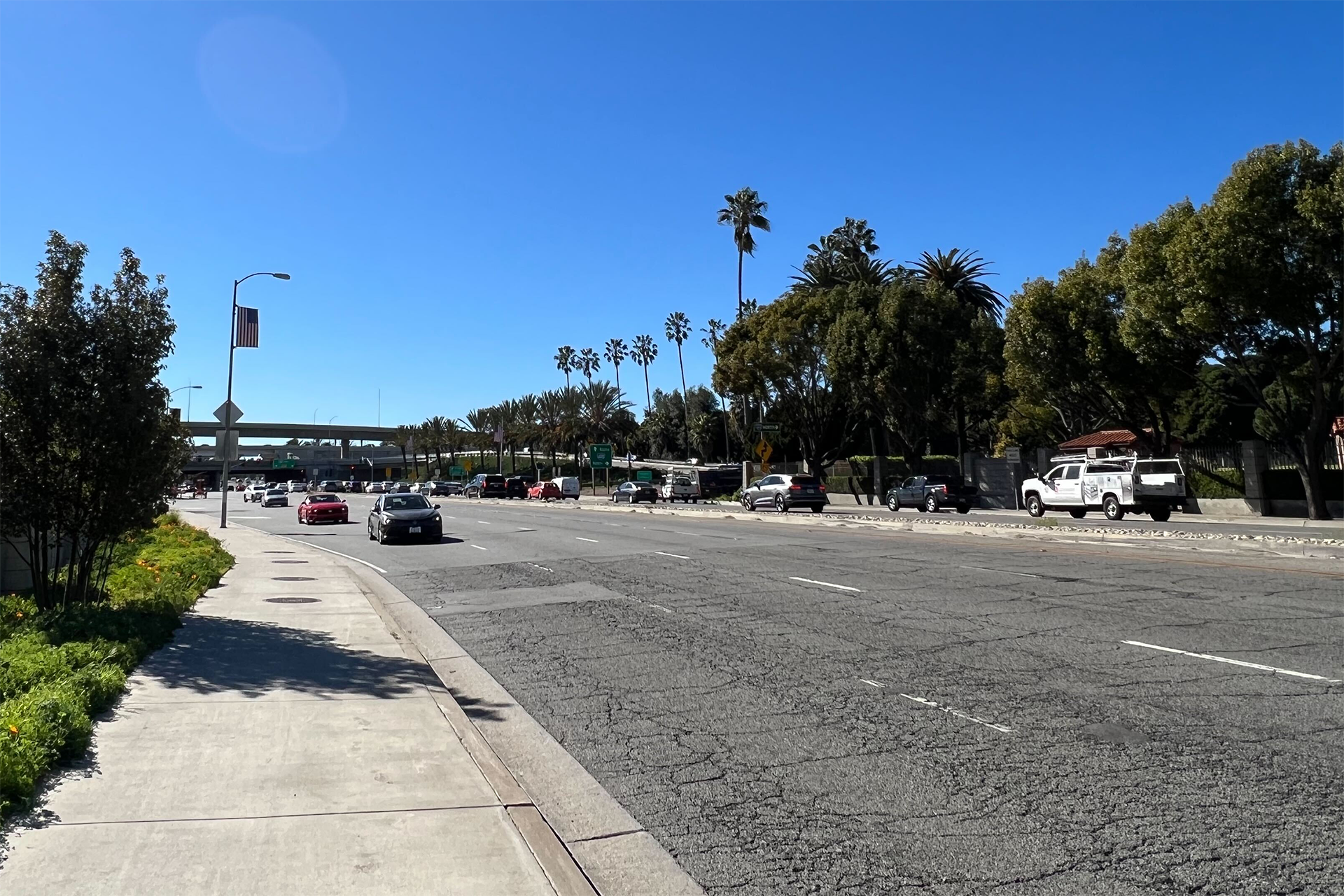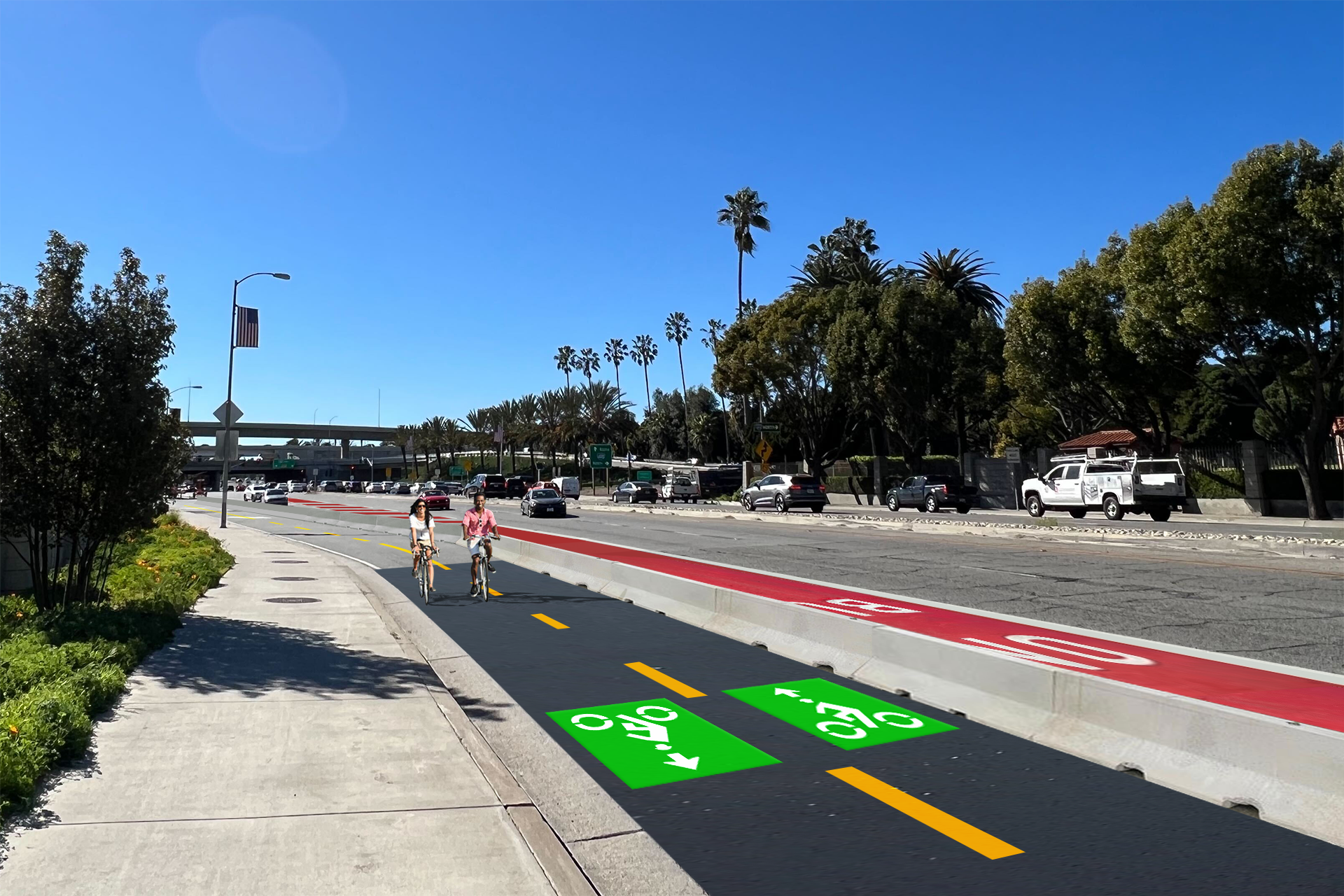We’re advocating for safer, greener, and more equitable Westwood.
🚇 A dedicated heavy-rail stop at UCLA
🚶♀️ Pedestrian improvements across Westwood Village
🚲 Protected bike lanes on Westwood, Wilshire, and Gayley
🚌 Contiguous bus lanes on Wilshire
UCLA Heavy Rail Stop
A dedicated Heavy Rail stop at UCLA is projected to be the busiest non-transfer station in Metro’s system, UCLA is the largest employer on the westside, and monorail won’t connect directly to UCLA, will come less frequently, and will take longer to travel to the Valley or (eventually) LAX.
We advocate for a heavy rail alternative route for the Sepulveda Transit Corridor, with a station on the main line (not a spur) located at UCLA’s Gateway Plaza and a direct transfer station at Metro’s future D-Line Westwood/UCLA station. As a once in a generation investment with the ability to transform UCLA, we must ensure connectivity with Metro’s larger system, with high capacity and quick travel times.


Traffic calming & street improvements on Gayley Ave:
One of the most important streets for UCLA students, Gayley acts as the main connection between UCLA’s Campus, the Hill, and the apartments. Despite high pedestrian traffic, the street still overwhelmingly favors vehicular traffic, placing students at risk of dangerous, and high-speed collisions, injuries, and even death.
Removal of one automobile traffic lane in each direction and the addition of protected bike lanes: Long promised but never implemented by ex-Councilmember Paul Koretz, it’s time to implement the Mobility Plan 2035’s protected bike lanes on Gayley, and calm traffic down to make it safer for people on bikes and on foot.
Implementation of new scramble crossings: Between Le Conte Ave and the Evergreen crossing at UCLA, we request the painting of scramble crossings at all signalized pedestrian crossings. These improve pedestrian visibility and safety.
Speed humps: Despite a posted speed limit of 30 mph, cars consistently speed down Gayley, disrupting UCLA students who live on the street and increasing potential conflicts between pedestrians and vehicles. We ask that the speed limit be lowered to 25 mph. We additionally ask for the installation of speed humps, bumps, or tables would force cars to adhere to existing traffic laws, mitigating the threats and severity of potential collisions. The speed humps should be installed in a way that does not impede the protected bike lane but only slows down motor vehicles.
Leading pedestrian intervals & no right turns on red: A leading pedestrian interval and the prohibition of right turns on red at the intersection of Gayley and Strathmore is critical to improve pedestrian safety at crossings. Pedestrian accidents are most common with turning vehicles; the implementation of these changes protects pedestrians from the threats of these turning cars.
Pedestrian safety improvements across Westwood Village
Westwood Village should be a walking paradise; making the Village safe and easy to walk around would be a boon to restaurants and small businesses. The Village has a 32% vacancy rate — the current setup optimized for cars isn’t working. Westwood Bl, Weyburn Ave, Tiverton Ave, and Le Conte Ave are all on the City of LA’s High Injury Network (the 6% of streets where 70% of injuries/deaths occur). Foot traffic to businesses in the Village would increase dramatically if people felt safer getting around, and more people would choose to walk over drive to avoid the stress of looking for parking.
Eliminate ‘Beg Buttons”: Automatic pedestrian signaling: “Beg buttons” are still used throughout UCLA’s campus, even at extremely busy intersections such as Bruinwalk and Charles E. Young Dr. When unpressed, beg buttons often encourage jaywalking, placing pedestrians and vehicles at risk of conflict. They exist to prioritize cars above people, which is the opposite of what we want for UCLA. Further, beg buttons have been removed elsewhere because of risks of disease spread, such as COVID-19. These high- contact surfaces should be eliminated at all intersections on UCLA’s campus, and all intersections should be converted to recall mode.
Raised crosswalks and intersections: Several important crossings rely on vehicles to yield the right of way to pedestrians at stop signs. However, we observe that often these vehicles fail to stop or even speed through these intersections, putting students at risk of crashes. These crosswalks or intersections should be raised to curb level to improve pedestrian visibility and to physically slow vehicles as they travel through the intersection.
Pedestrianize Broxton: We support initiatives by the North Westwood Neighborhood Council and the Westwood Village Improvement Association to create a pedestrian plaza on Broxton.
Bulb Outs: We ask for the implementation of new bulb-out curb extensions throughout the Village, providing higher pedestrian visibility and slowing cars as they approach intersections. For streets with bike lanes, they should be designed in a way that does not interfere with the bike lane. At a number of intersections in the Village (e.g., Levering and Gayley) and in the neighborhood to the west of campus (e.g., Landfair and Strathmore) where two streets intersect at an odd angle, bollards and bulb-outs should be used to transform the intersections closer to right-angles, to improve visibility and safety.
Traffic Circles: We ask that the City consider adding neighborhood traffic circles along low-vehicle-traffic-volume neighborhood bike routes, like those on Westholme currently, given their demonstrated safety benefits.


Protected bike lanes on Westwood Blvd
As part of LA’s High Injury Network (6% of streets that cause 70% of injuries/deaths), we wish to see Westwood Blvd. transformed into a place where students can safely commute from Ackerman Union to the Expo Line in a protected bike lane. This would involve creating new bike lanes south from campus to Wellworth, where current bike lanes exist, and upgrading the unprotected bike lanes between Wellworth and Santa Monica Blvd. to protected. Lastly, the creation of new protected bike lanes between Santa Monica Blvd. and the Expo line station south of Pico. We also suggest that they be continued to National, where current bike lanes exist. All of these bike lanes are part of the City’s Mobility Plan 2035. Current conditions for pedestrians and cyclists are unsafe and unacceptable.
Reopen Constitution Ave to the public
The gates at either end of Constitution Ave through the Los Angeles National Cemetery have been locked to the public for over 20 years, forcing students and commuters trying to navigate across the 405 from Westwood to travel nearly a mile out of their way - including along a busy and dangerous section of Wilshire Blvd. Constitution Ave should be opened up to walking and rolling to increase E/W connectivity.


Fix multi-modal gaps on Wilshire Blvd
Extend Bus Lanes: The current Wilshire Blvd. bus lane is hampered near the 405, as it currently ends at Veteran going west and then picks up again Federal/San Vicente. It would make sense to plug this gap and have a continuous bus lane west of Veteran. We would also like to see the gap in the bus lane through “Condo Canyon” plugged; there is no reason why Wilshire Blvd. has to be built like a highway – in some sections, there are more than 10 lanes across. The bus lane should connect East of Selby to Comstock, where it currently picks up. Lastly, we would like to see the bus lane become 24/7, and not just be at rush hour. Two traffic lanes in each direction is plenty of space for private vehicles, and we should be prioritizing the most efficient forms of transportation to help incentivize it and fight climate change.
Extend and Protect Bike Lanes: The Wilshire Blvd. bike lane is currently an unprotected bike lane on a street where cars consistently go over 45 miles per hour, against all best practices for safety. It’s rarely used because only the bravest of cyclists would dare use it. The bike lane should be physically protected, ideally with a concrete curb, and extended east of Comstock to the Beverly Hills border per the Mobility Plan 2035 (hopefully continue it in coordination with Beverly Hills to Santa Monica Blvd.), and should be extended west of Selby all the way to Federal/San Vicente. This would provide a safe and continuous facility from Ocean to West Hollywood.




